The Pros and Cons of Metal Roofing
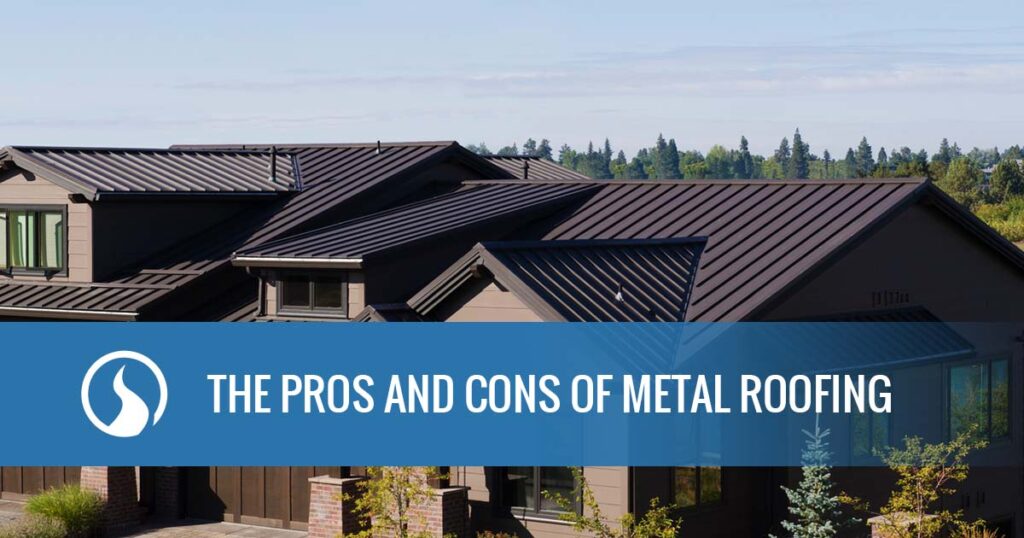
Metal roofing is no longer an outdated roofing material. Modern technology has given metal roofs new life, allowing them to become stylish, durable roofs for any home. Metal roofing is an excellent option for any homeowner looking to improve their roof’s look, strength and life span.
Like every roofing material, there are benefits and downsides to installation. Let’s explore metal roofing options, what the problems with metal roofs are and how they can benefit your home.
Metal Roofing Types
Before diving into the advantages and disadvantages of metal roofs, you should understand what they are and what their installation systems look like. Different metals will affect your roof’s price, life span and look. The more expensive the metal, the more durable the roof, but you should consider your home’s design and budget before settling on a material.
You’ll come across three potential metals when looking for residential metal roofing:
- Steel: This is the most common metal for residential roofing. There are different steel gauges — higher numbers indicate thinner metal. Thinner gauges are more at-risk for oil canning, which happens when the panels are installed too tightly. Steel should have a resistant finish painted over the top to protect it from damage.
- Stainless steel: Stainless steel is less popular than standard steel. It’s tougher than regular steel and isn’t as prone to denting, but this increased durability will increase your costs. Stainless steel is more expensive than copper or steel, which is why you’ll see it less.
- Copper: Copper is extremely popular for residential roofs. It’s an excellent, long-lasting material that also serves as a stylish accent for your home.
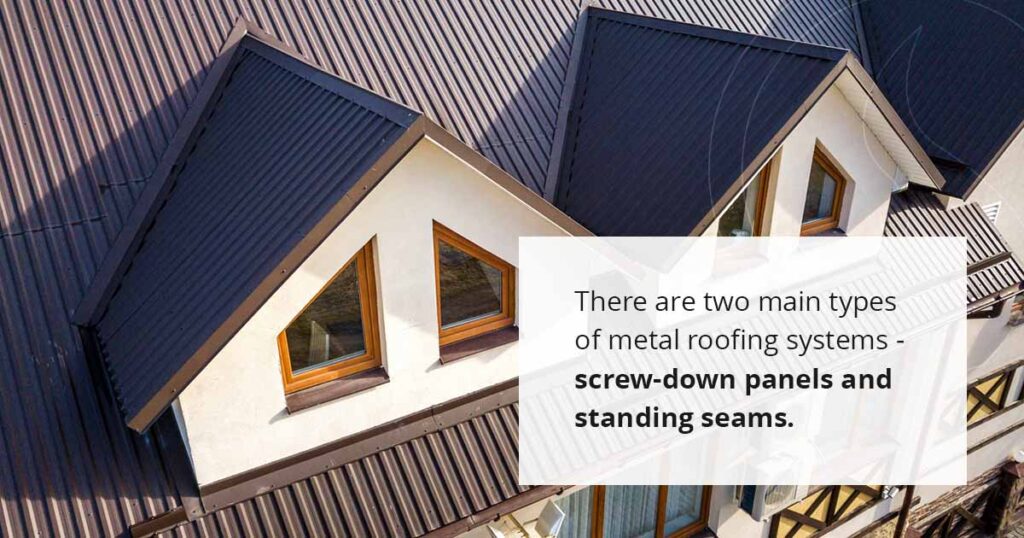
There are two main types of metal roofing systems — screw-down panels and standing seams. Depending on the metal roof system you install, you might have to perform more maintenance or replacements down the road. Typically, you’ll want a standing seam metal roof for your residential home. Let’s review why:
Screw-Down Panel
Screw-down panel roof systems are installed using screws. These screws are pushed straight through each metal panel, which limits the movement the panels can have.
Some movement is essential for metal roofs — they expand and contract with the weather, and without room to move, the screws wallow out. Eventually, you’ll need to replace the screws with larger and larger ones over time, and you’ll end up dealing with leaks.
Standing Seam
Standing seam systems have the advantage for residential homes. These metal roofs have panels that are locked together at each seam.
This is done mechanically — each panel edge has a clip underneath that attaches to the next panel, holding them together while still allowing for expansion and contraction. This reduces your chances of leaks and ensures you don’t need a screw replacement every few years.
A standing seam system will also have a longer life span and less maintenance than a screw-down roof. You’ll enjoy your roof for longer, and the interlocking panels create a stylish, stand-out roof for your home.
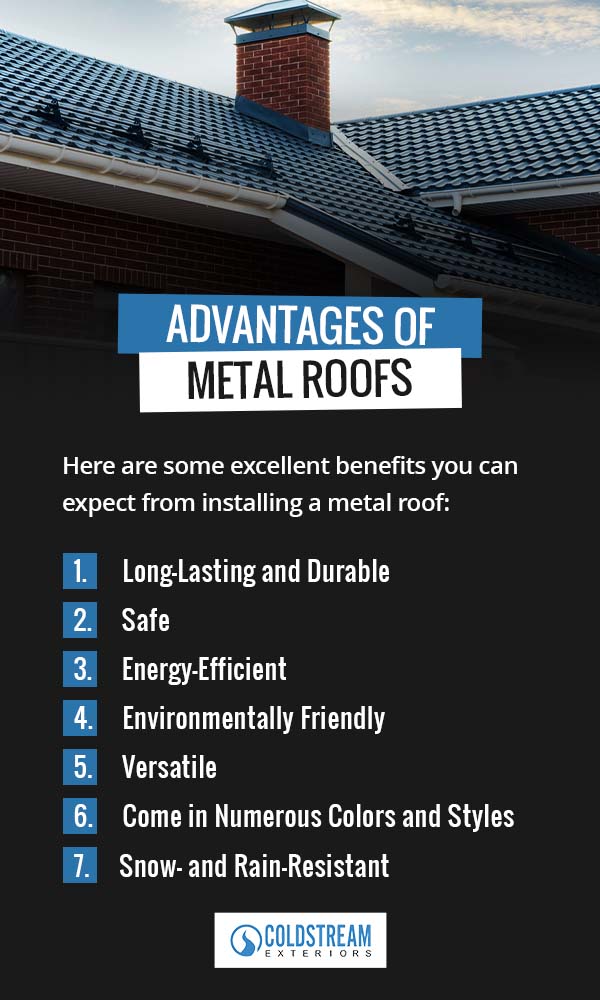
Advantages of Metal Roofs
There are numerous advantages to having a metal roof. They’re a great option for most homeowners and add a distinct look to your home. Here are some excellent benefits you can expect from installing a metal roof:
1. Long-Lasting and Durable
Metal roofs have incredible longevity. A standard metal roof will last between 40 to 80 years, while a copper roof can last 70 or more. Coldstream Exteriors’ metal roofs are designed to withstand years of weathering without needing a roof replacement in Cincinnati.
This decades-long life span is why many homeowners make the switch to metal after their asphalt roof needs replacing. Asphalt roofs only last 20 to 30 years, and the shingles need occasional replacing even before then.
You won’t have to worry about broken or missing shingles with a metal roof. The metal sheets are locked together and won’t separate easily. You’ll have an easier time maintaining the roof, and it’ll handle debris better than other, less-durable roofing materials.
2. Safe
Metal roofs are extremely safe. The metal they’re made with is highly-resistant to fire damage, unlike other, more flammable roofing materials.
Further, metal and metal roofs don’t attract lightning, and metal roofing won’t spark or catch fire even if lightning strikes or fires occur. This resistance makes them an excellent choice for homes where fire safety is a primary concern.
3. Energy-Efficient
Another benefit of having a metal roof is energy efficiency. While you’ll pay more upfront for metal roof installation, you’ll save big on your energy bills over time. Metal is highly reflective — your roof will bounce the sun’s infrared and ultraviolet rays back away from the house instead of absorbing them like other roofing materials.
Normally, an asphalt roof will absorb some of the sun’s rays, hanging onto them and increasing the work your cooling system has to do. Since metal reflects these rays, your roof and home will stay cooler during the summer with less effort. Your cooling system won’t have to work as hard, and your energy costs may decrease.
Additionally, many companies offer special coatings for metal roofs that increase their efficiency further. Reflective pigments are available that minimize heat gain even further for increased energy savings.
4. Environmentally Friendly
Metal roofs are a good option for anyone looking for an environmentally friendly roofing material. Asphalt shingles are made from petroleum and increase dependency on fossil fuel products. Additionally, they need to be replaced every couple of decades, increasing landfill waste.
Metal roofs are made from recycled material and are almost fully recyclable once they’ve reached the end of their life spans, making them much more sustainable than asphalt shingles. They also have the added benefit of being the perfect foundation for greener home energy. Metal roofing provides a strong, lasting foundation for solar panels or rainwater-harvesting systems.
You can transform your roof into a sustainable structure easily with metal roofing.
5. Versatile
You can install metal roofing even if you have a low-pitched roof. Other roofing materials, like asphalt shingles, can’t go on low-pitched homes. Tiles and asphalt shingles need a higher pitch, or they don’t perform well. Metal can go on low-pitched roofs, allowing you to have durable, attractive roofing for your home, even if it has an unusual pitch.
The varying thinness options for metal roofing also make them adaptable to your unique home. If your roof requires something lighter, you can select a metal that fits your roof decking’s needs. A construction company will evaluate your roof to determine what weight it can handle, and you’ll select a metal from their lighter or heavier options.
6. Come in Numerous Colors and Styles
Metal has come a long way, and you no longer have to settle for a plain-colored roof. Metal roofing now comes in dozens of colors and potential styles to fit any home design. You can easily select a stylish metal roof option that increases the strength and value of your home without issue. Consider playing with contrasting colors and unique finishes to make your roof stand out from the rest.
Metal roofing can come in styles that mimic more traditional roofing materials. Aside from the vertical panel look, you could get a roof that resembles tile, slate or even wood shakes. With multiple-layer finishes, your metal roof can take on a sophisticated appearance that looks like the material of your choice.
7. Snow- and Rain-Resistant
While asphalt shingles and tile keep water out of your home, they can’t compare to the waterproof design of metal roofing’s interlocking panels. The hard, slippery metal makes it difficult for snow and rain to settle onto metal roofs.
Instead, the rain and snow will slide off your roof into the gutters. When the sun arrives, the metal will reflect its heat and help evaporate the moisture much more quickly. With a good water and ice barrier, you won’t have to stress about ice dams and leakage.
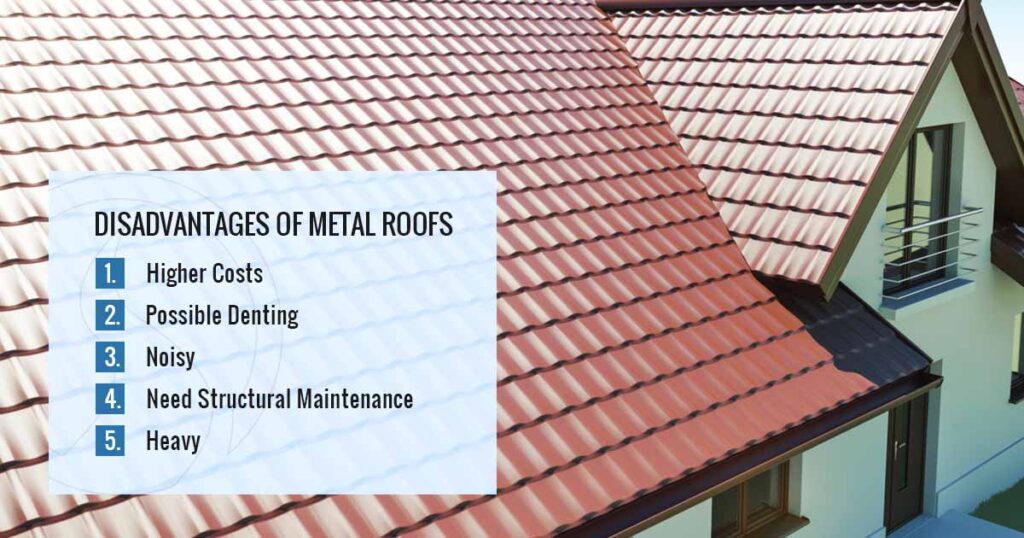
Disadvantages of Metal Roofs
While there are lots of benefits to installing metal roofing, everything has some potential drawbacks. Some benefits might be worth it to you, while specific downsides could be deal breakers. Weigh everything carefully to ensure you get the right roof for your needs.
1. Higher Costs
Metal roofs are more expensive than asphalt shingle roofing. They cost about as much as other premium roofing materials, but they can get even more costly if you choose stainless steel for your material.
The trade-off is high durability, long life and lower energy costs. By investing in a quality roofing material now, you can ensure your home stays protected, and you may even see cost-savings in the long run. Finding a reputable roofing company with the experience and qualifications for metal roof installation will ensure you get your money’s worth out of a job.
2. Possible Denting
While metal roofs are highly durable and designed to withstand extreme weathering for years, they can dent. Heavy falling branches or large hail can create dents in your metal roof if they’re big enough and fast enough.
If enough dents accumulate over time, it can lead to a less-attractive curb appeal. However, you can prevent denting to an extent. Steel is much harder than copper and won’t dent as easily, keeping your roof pristine through any storm.
3. Noisy
Rain, sleet and debris falling on a metal roof can all create loud, intrusive sounds. These loud noises may be especially easy to hear on the top floors of your home, which are closest to the roof.
Fortunately, you can cut the noise almost entirely with quality insulation under your roof and extra solid sheathing layers. Make sure to get good, thick insulation with your new metal roof, and you’ll save on energy costs and reduce noise levels.
4. Need Structural Maintenance
While regular roof maintenance is essential for any roofing material, metal requires some material-specific care every few years. Along with standard roof maintenance and checking for signs of roof damage, you might also need to hire a professional to perform structural maintenance.
This expert maintenance ensures the roof continues to stand strong and there are no problems caused by wear and tear or weathering. While it’ll be an investment, it’s much less expensive than completely replacing your metal roof due to ongoing structural problems.
5. Heavy
Metal is a heavy material on its own — this can lead to problems if you’re trying to install metal over your existing asphalt shingles. Without proper evaluation and solid roof decking, the weight of metal over your shingles can cause structural damage to your roof and home. Left unaddressed, you’ll have a severe roofing problem on your hands.
Hiring a quality roofing company will help ensure your roof decking doesn’t experience issues when installing metal over shingles. A thinner metal can relieve some of the stress on your roof, giving you a new metal roof without having to tear out the old asphalt shingles. Keep in mind that it might make it harder for you to find leaks and repair issues in the future.
Consult with your roofing company to prevent problems with your metal roof and roof decking. Make sure covering your shingles with metal is the right choice — it might be easier to replace the entire roof now instead of covering it up. They’ll advise you on the safest, most cost-efficient option for your home.
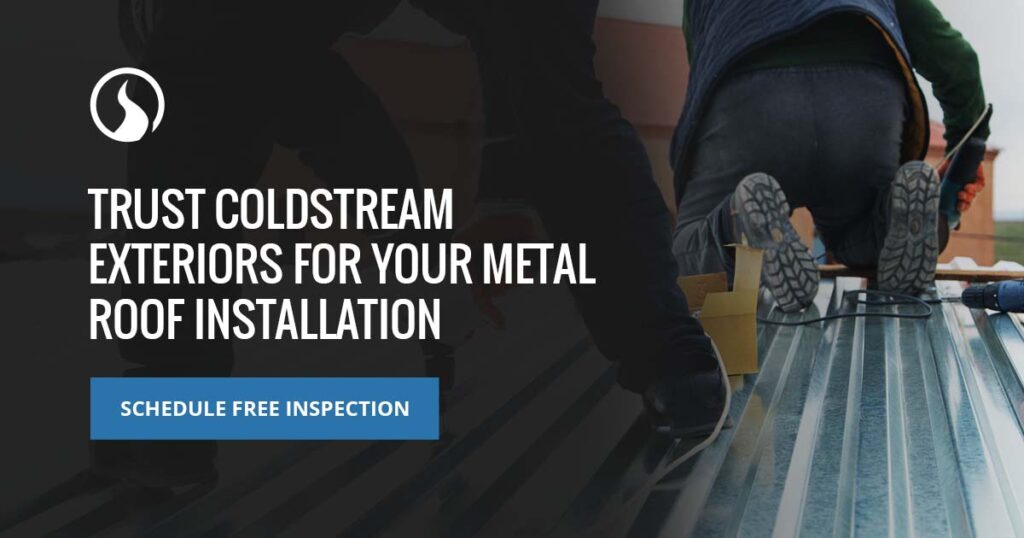
Trust Coldstream Exteriors for Your Metal Roof Installation
Enjoy a durable, weather-resistant roof year-round when you replace your roof with metal. At Coldstream Exteriors, we offer premium roofing services at affordable rates for all our customers. With high-quality roofing services, industry-leading warranties and unmatched customer service, we make your roofing job as easy and stress-free as possible.
As a three-time recipient of the Angie’s Super Service Award and ranked A+ by the Better Business Bureau, Coldstream Exteriors is the premier roofing service choice for your home project. We offer window, gutter and siding services in addition to our roofing options.
If you’re looking to start your next roofing project in the Greater Cincinnati, Tampa or St. Louis areas, contact us online to schedule your free inspection today.
